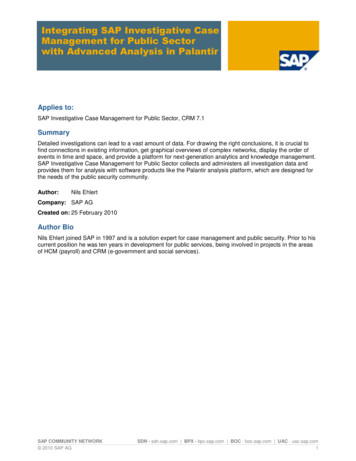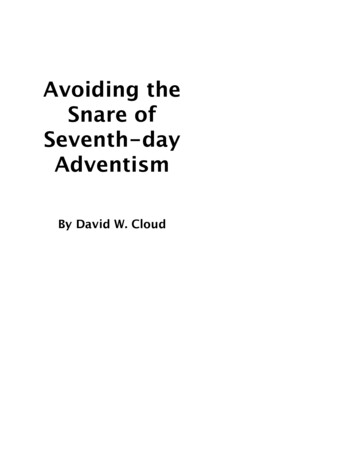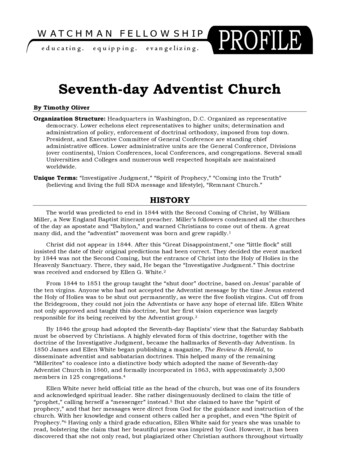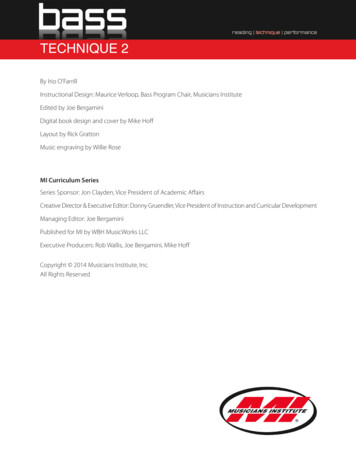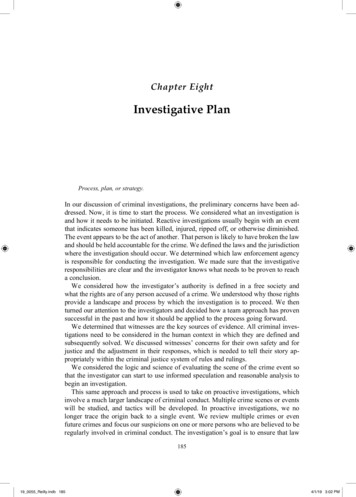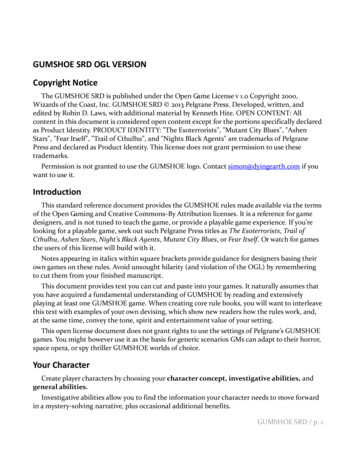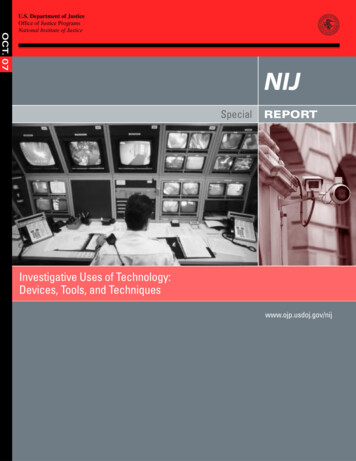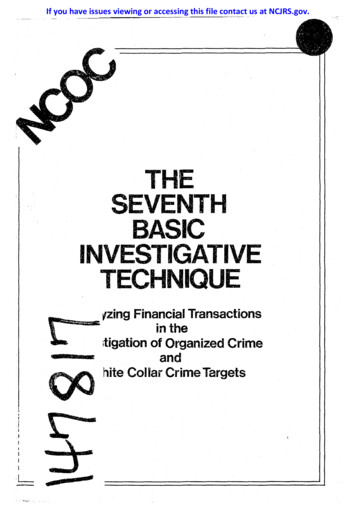
Transcription
If you have issues viewing or accessing this file contact us at NCJRS.gov. ----- - THESEVENTHBASICINVESTIGATIVETECHNIQUEr.Fl7.()Cl. !I,III.,--,fzing Financial Transactionsin the,tigation of Organized Crimeandhite Collar Crime Targets
U.S. Department of JusticeNational Institute of Justice147817This document has been reproduced exactly as received from theperson or organization originating it. Points of view or opinions stated Inthis document are those of the authors and do not necessarily representthe official position or policies of the National Institute of Justice.Permission to reproduce thisgranted byiI!i.&0 material has beenPublic Domain/LEAADepartment of Justiceu.s.to the National Criminal Justice Reference Service (NCJRS).Further reproduction outside of the NCJRS system requires permissionof the owner.The preparation of this handbook was financed by a grant fromthe Law Enforcement As istance Administration.The fact that the Law Enforcement Assistance Administrationfurnished financial support for this project does not necessarily indicateits concurrence in the statements or conclusions herein.Any publication or duplication of the handbook without the express written permission of the author is prohibited.Project Monitor:James Golden, Director, Enforcement Program Division,Law Enforcement Assistance Administration. "I
THE.SEVENTHBASICINVESTIGATIVETECHNIQUEAnalyzing Financial Transactionsin theInvestigation of Organized CrimeandWhite Collar Crime TargetsAuthor:Richard A. Nossen, Consultant,Criminal Justice Systems-White Collar CrimeInvestigative Techr.iques
FOREWORDThis handbook, entitled, The Seventh Basic Investigative Technique.was prepared to meet repeated recommendations made formally andinformally by key speakers, panel members, workshop group leadersand participants at the October, 1975 National Conference on Organized Crime. Their recommendations strongly urged the Federal Government to develop training materials geared to the needs of lawenforcement officials in the area of tracing financial transactions entered intoby organized crime and white collar crime igures.The handbook highlights an approach to the investigation oforganized crime and white collar crime targets by criminal investigatorsthat was introduced to and enthusiastically received by state and locallaw enforcement officials who attended a series of LEAA regional conferences on organized crime beginning in 1970 at Zion, Illinois, andculminating at the February, 1972, conference at San Diego, California.The handbook was prepared by Mr. Richard A. Nossen, a CriminalJustice Systems Consultant, who, while serving as Assistant Director ofthe Intelligence Division and in other subordinate positions with theU. S. Internal Revenue Service, developed and presented the conceptof applying financial investigation techniques to criminal investigationsat the series of organized crime training conferences mentioned in thepreceding paragraph.This publication, which is another direct outgrowth of the proceedings of the National Conference on Organized Crime, is but one ofmany attempts being made by LEAA to meet their commitment tolocal law enforcement, mandated in the primary objectives of theNCOC, i.e.,"To present the current state-of-the-art in organized crimecontrol for the information and education of state and localcriminal justice and public organizations whose activities andsupport are necessary in controlling the problem of organizedcriminal activity nationwide."III
The handbook will accordingly be distributed to all NCOC participants and will be included as an appendix to the Investigator's Manualpresently being prepared by the Battelle Memorial Institute under anLEAA grant. It will also be available in the library of the NationalInstitute of Law Enforcement and Criminal Justice.It is our sincere hope that this latest investigative tool, added tothe arsenal of other training materials developed and furnished to lawenforcement officials by LEAA, will lead to further successes in ourmutual efforts to control Organized Crime and White Collar Crime inthe United States. W Richard W. VeldeAdministratorIV
TABLE OF CONTENTSPageChapter IIntroduction To The Seventh Basic Investigative Technique. . . .1-4Chapter IIApplication of the Net Worth-Expenditures PrincipleDefinition .Application. . . . . . . . . . . . . . . . . . . . . . . . . . . . . . . . . . . . . .55-6Chapter IIIPractical ExerciseFactual Situation. . . . . . . . . . . . . . . . . . . . . . . . . . . . . . . . . .I nvestigative Steps. . . . . . . . . . . . . . . . . . . . . . . . . . . . . . . . .Safe Deposit Box. . . . . . . . . . . . . . . . . . . . . . . . . . . . . .Checking Account .Cashiers' Checks - Bank A .Security Account. .Automobiles . . . . . . . . . . . . . . . . . . . . .Savings Account - Bank B. . . . . . . . . . . . . . . . . . . . . . . .Cashiers' Checks - Bank B. . . . . . . . . . . . . . . . . . . . . . . .Travelers Cheques .Fur Coat. . . . . . . . . . . . . . . . . . . . . . . . . . . . . . . . . . . . .Diamond Ring. . . . . . . . . . . . . . . . . . . . . . . . . . . . . . . .Condominium Apartment .Source and Application of Funds Schedule .Net Worth and Expenditures Schedule .Additional Living Expenses .Impact of Cash on Hand on Computations .Continued Ownership of Assets .Summary. . . . . . . . . . . . . . . . . . . . . . . . . . . . . . . . . . 29-3030-3131-3333-3434Chapter IVSources of InformationIntroduction .35Authority to Obtain Information . 35-3637Bank Records. . . . . . . . . . . . . . . . . . . . . . . . . . . . . . . . . . . . .Internal Bookkeeping Procedures. . . . . . . . . . . . . . . . . . .37Retention of Records . 37-3839Recognizing "Cashed" Checks. . . . . . . . . . . . . . . . . . . . .Bank Identification Symbols . 40-43V
TABLE OF CONTENTSPageNational Credit CardsBankAmericard . " 44-45Master Charge .45American Express .46Travelers ChequesAmerican Express . . . . . . . . . . . . . . . . . . . . . . . .46Citibank of New York. . . . . . . . . . . . . . . . . . . . . . . . . . .46Bank of America . . . . . . . . . . . . . . . . . . . . . . . . . . . . . .46Analyzing Customer Security Account Statements . 46-48Chapter VSummary . " . . . 49-50VI
CHAPTER IIntroduction To The Seventh Basic Investigative TechniqueFor countless years, criminal investigators have relied on six basicinvestigative techniques to solve crimes; i.e., (1) the development ofinformants, (2) use of undercover agents, (3) laboratory analysis ofphysical evidence, (4) physical and electronic surveillance, (5) interrogation, and (6) where permitted by law, wiretapping. Each of thesetechniques has resulted in varying degrees of success.The purpose of this handbook is to introduce to criminal investigators, on a broad scale, an investigative tool, a seventh basic investigativetechnique, used primarily in the investigation of violations of the Federalincome tax laws. This tool, if properly applied, can greatly enhance thesuccess of the investigation of cases where illegal profits and a greed forwealth are the principle motives of the violators.Excluding crimes of passion, it is difficult to isolate a motive forcrime other than monetary gain. Racketeers who violate the narcoticlaws, engage in hijacking, fencing, shyiocking, gambling, prostitutionrings, etc., as well as white collar type criminals engaged in more sUbtlecrimes such as commercial bribery, political corruption, etc., are motivated by the same common denominator -- a desire for financial gainand the power that it commands.It follows, therefore, that if money is the primary motive behindthe crimes committed by both racketeer and white-collar type criminals,the use of the Seventh Basic Investigative Technique must be added tothe skills of criminal investigators to ensure optimum success in theirultimate prosecution.All too often in the past, criminal investigators have been reluctantto broaden the scope of their investigations into the financial area,thereby sacrificing the potential evidentiary value of leads that may havebeen successfully developed if properly explored. This reluctance isunderstandable, and was caused, in part, by an inhibition that hasexisted for years among criminal investigators that financial transactions,for the most part, were difficult to investigate unless the investigatorshad an accounting background. Rather than take positive action to overcome this inhibition, many crimina! investigators took a negative approach and merely dismissed the need to investigate financial leads byrationalizing their minimal evidentiary value.'1
As a result of this general reluctance to probe the financial activities of the racketeer - white collar crime element, an attitude hasdeveloped among criminal investigators that if the six basic investigativetechniques do not result in a successful investigation, drop the investigation or, perhaps, turn the information over to I RS; in the mistakenbelief that I RS agents have a monopoly on the capabilities necessary todevelop evidence relating to financial transactions.On the contrary, it is the writer's experience, shared by manyothers with similar investigative backgrounds, that .ill! criminal investigators, at the Federal, state and local level, can and, when appropriate,should investigate financial leads and analyze financial transactions inthe same competent and professional manner as demonstrated by theirdevelopment of interrogation skills, networks of informants and theoverall application of investigative innovativeness that they have so ablyutilized in the successful investigation of organized crime and whitecollar crime cases in the past.The following chapters in the handbook, therefore, were developedto provide journeymen criminal investigators with the tools necessaryto explore, develop and carefully follow financial transactions engagedin by the targets of their investigations with complete confidence thatthey will soon master the technique. While the application of thesetechniques is not expected to wipe out the racketeer-white collar typecriminal element engaged in crimes that are "money motivated," thereis every reason to believe that, properly used, the "seventh basic investigative technique" can and will become another major weapon in thecontrol of organized and white collar crime.In studying the following chapters, it is imperative to keep in mindthe primary objective of all criminal investig.;;ltors; that is, to developadequate credible evidence against targets that will not only convinceprosecutors that prosecutive action is warranted; but will enable themto successfully present the evidence to grand juries and to the Courts.It is the author's view, based on his own experience and on hisassociation with judges and prosecutors throughout the United Statesover a period of more than two decades, that they are far more favorablyimpressed with evidence, such as that reflected in the following chaptersof this Handbook, than with speculation that many investigators, at alllevels of Government, have too often engaged in for too long, using2
such tired old phrases as A is "tied in" with Band C "meets frequen 1:ly"with D; all of which adds up in the minds of prosecutors as 50 muchtrivia.It takes evidence to get a conviction, and in the area of today'sorganized and white collar type crimes, the need to gather evidence oftargets' financial transactions has become critical.For the purposes of this Handbook, the title, criminal investigator,includes all Federal, state and local investigative personnel charged withresponsibility to Investigate violations of criminal statutes,. who have notutilized investigative accounting techniques in the investigation of financial crimes; including, but not limited to, agents of the Department ofthe Treasu ry and the Department of Justice at the Federal level, as wellas investigators on the staffs of state attorneys' general, county districtattorneys' investigators hired by or assigned to grand juries and crimecommissions and members of state, county and city police departments.3
4
CHAPTER IIApplication of the Net-Worth-Expenditures PrincipleDefinitionBefore explaining how the net worth-expenditures principle can beused in the investigation of racketeer and white collar crime targets, itis necessary to clearly define the principle.The net worth-expenditures principle, as used in this handbook, isa mathematical computation designed to determine the total accumulation of wealth and annual expenditures made by an individual. Theprinciple has been used for many years by the U. S. Internal RevenueService for the purpose of determining taxpayers income tax liabilities,primarily in those instances where no books or records of income andexpenses have been maintained by taxpayers from which a determination of tax liability could be made.The use of this principle by the I RS in making a civil determinationof taxpayers' income, has been upheld by the U. S. Supreme Court. Theprinciple has also been upheld by the Supreme Court when used toestablish one of the elements of proof of criminal tax fraud, i.e., that ataxpayer has, in fact, understated his income, upon which an additionaltax is due and owing.The net worth and expenditures computation, when used by IRSto determine tax liabilities for either civil or criminal purposes, is complex. However, the complexity is caused not by the net worth principle,itself, but by the fact that the computations must be made, taking intoaccount the highly complex tax laws. In other words, adjustments haveto be made to ensure that tax liabilities, computfld by the applicationof the net worth principle, take into account the effect of the receipt,by taxpayers, of non taxable, or partially taxable income.The use of the net worth and expenditures principle by criminalinvestigators for the purpose outlined herein is not as complex anc!c.?nbe developed with comparative ease. It can be applied effectively incriminal investigations without regard to the tax laws, whatsoever.ApplicationThe net worth-expenditures principle can be applied, when appropriate, to: (1) gather intelligence, (related to financial transactions),(2) enhance the successful interrogation of a target, (3) corroborateother evidence of a crime for the purpose of presenting facts to, (a) the5
district attorney for his consideration, (b) a grand jury, or (c) a trialjury, or to the Court in the event of a bench trial, (4) assist in determining whether a target is engaged in other crimes, (5) determine havenswhere a target may be hiding assets, and, (6) to identify or locate assetsfor restitution or collection of fines.The computation can be presented in two formats. One is commonly referred to as a "Net worth-Expenditure Schedule;" the other isperhaps more readily recognized as a schedule of "Source and Application of Funds." Either format will produce, essentially, the same result:The net worth format should normally be used when a target's spe!ndinghabits appear to include the acquisition and disposal of real Hstate,jewelry, furs, bank accounts, life insurance policies having a cash valueand periodic reductions of mortgage loans. The source and applicationof funds schedule is normally used when a target's expenditures havebeen of a more transient nature, such as for high personal livingexpenses.Illustrations of both schedu les, based on the same hypotheticalpractical exercise, are contained in the following chapter.6
CHAPTER IIIPractical ExerciseFactual SituationTarget "A" has been identified over a period of years as beinginvolved in major fencing operations. While he has been the subject offrequent investigations he has successfully avoided indictment. Hisownership of a retail furniture store, which investigators are convincedis a cover, has successfully shielded his fencing operation. A warehouse,allegedly maintained as a storage facility for furniture and other merchandise related to his retail operation, is located so as to make physicalsurveillance difficult. Allegations and raw intelligence have failed tomeet the test for probable cause to obtain a search warrant.One of the investigators assigned to Intelligence has gained theconfidence of Target "A's" bookkeeper, who informed the investigatorthat the Target's furniture store is generating only nominal profits; thatshe has access to cop!es of his annual profit and loss statements andbalance sheets for the past four years prepared by the Target's accountant and overheard the Target inform his accountant that the profit andloss statements of the furniture store operation reflected his sole sourceof income. She voluntarily furnished the investigator with copies of theprofit and loss statements and balance sheets for the years 1972 through1975.The profit and loss statements disclosed net profits of 14,000, 16,250, 11,750 and 14,375 for the years 1972 through 1975, respectively. The balance sheets disclosed a balance in the Target's capitalaccount of 15,000 for each of the years 1972 through 1975, respectively. No additional investments were made since the Target made hisinitial investment in the business in 1972. Earnings, reflected above,have been withdrawn from the business each year.A realistic factual background accordingly exists which wouldwarrant the application of investigative resources to explore the"Seventh Basic Investigative Technique."Investigative StegsThrough physical surveillance the investigator observes the Targetenter Bank "A". Upon making inquiry at the bank, the investigatorlearns that the Target has a commercial account and safe'deposit boxand that he obtained a Bank Americard through the same bank.7
Safe Deposit BoxThe investigator obtained a copy of the safe deposit box contractfiled with the bank by the Target at the time he applied for the safe deposit box rental. The contract, shown below, (Illustration 1), not onlydiscloses a physical description of the Target and an exemplar of hishandwriting, but contains other pertinent background information aswell:Illustration 1No.SAFE DEPOSIT-INDIVIDUALILESSEEDEPUTYDATE OFCONTRACTRENT --------------8
Illustration 11:.;:9'-- hereby designateand appoint1'-'9'-- hereby designateand appointas deputy and agent, to have access to the boxcovered by this contract. To take and remove from oradd to the contents thereof, and have full and absolute control over the same, hereby waiving any liability of the lessor, arising out of the exercise, by thesaid deputy, or any of the powers herein contained.asdeputy and agent, to have access to the boxcovered by this contract. To take and remove from oradd to the contents thereof, and have full and absolute control over the same, hereby waiving any Iia·bility of the lessor, arising out of the exercise, by thesaid deputy, or any of the powers herein ess:Witness:Address of DeputyAddress of DeputyThe Appointment Of The Above Deputy Is HerebyThe Appointment Of The Above Deputy Is essPhoneMothersMaiden NamePhoneMothersMaiden NamePhoneMothersMaiden NameColor Of HairColor Of HairColor Of HairColor Of EyesColor Of !;yesColor Of arksRemarks9
Each time an individual enters his safe deposit box, he is requiredto sign an entry slip, (Illustration 2), shown below:Illustration 2ENTRY SLIPThe undersigned lessee or authorized deputy desires access to safe deposit box.SignatureLessee 0 r Deputy[ Boo," No.IIAU,"d,d ByBox No.14-0007The entry slip discloses the date and time of day that an individualenters his safe deposit box. It is usually stamped on the reverse side inorder that the individual's signature can be identified. This informationcan be of inestimable value to an investigation since the dates of entryinto a safe deposit box may reconcile with the dates of other cashfinancial transactions. (This will be illustrated in subsequent paragraphs).The information can also be used by an investigator to contradict atarget's alibi as to his whereabouts during a key interrogation or by aprosecutor during cross examination of a target at trial.The record of entries into a safe deposit box should, accordingly,be obtained on every target whose financial transactions are being investigated and those targets on whom "financial intelligence" is beinggathered.The record retention period for safe deposit box entries variesamong banks. However, many banks continue to retain the records wellbeyond the scheduled destruction date due to the limited storage spacethey require and the cost of manpower to meet record destructionschedules. 1/7 any event, the information should be obtDined as quicklyas possible; as soon as a target is placed under financial investigation oridentified as a suspect on whom intelligence is to be gathered.10
The record of entries by the target into his safe deposit box, forthe purpose of this exercise, is shown in Illustration 3 below: (Thisparticular bank's entry record form provides for a four year record,however, only two years are illustrated below).Illustration 3NAME OFLESSEEBOX NO.RECORD OF VISITS -' iREMINGTON RAND197"I2345SAFE DEPOSIT67K' .,.C.,T. NO. 1T29 30 II12131415JAN197'4"JANFEBFEB.MARMARWI APRMAYJUNEJUNE JULY.,APRMAYv'I I121314151611171819ZO21222324252627 2B
Checking AccountIllustration 4, shown below, is a copy of the signature card relatingto the target's checking account. This card, again, furnished the investigator with an exemplar of the target's handwriting as well as backgroundinformation of interest.Illustration 4PERSONAL DDA SIGNATURE CARDD JOINTD INDIVIDUALACCOUNT NUMBER1Please STAMP Bank Name HereAccount Name:SEALAccount Name2SEALSocial Security NumberSEALI (we) the above-signed, have peen provided with and have read the rules and regulations ofBank governing this account and agree to be bound by the provisions tl1ereof, and as they shall,from time to time, be amended bY the Bank.If two or more signatures appear above, each agrees that all moneys, checks and otherInstrUments for payment of money at any time deposited In this account are and will be theirJoint property during their Joint lives and upon the death of either of them the entire right, titleand Interest therein shall vest absolutely In the sur!vior; that at any time the balance In thisaccount shall be subject to withdrawal, transfer or other diSPosition, In whole or In part, byeither of them, or the duly constituted attorney of either of them without duty of Inquiry onyour part) that payment to, or bY order of, either of them, or the duly constituted attorney ofeither of them, shalJ be full discharge to YOu for such payment, whether the other be living,Incompetent or deceased; that you .shall be authorized to make payment In accordance with theterms hereof, not Withstanding any notice or demand which may be given by or on behalf ofeither of them to the contrarY. The Bank Is authorized to off-set the balance, without notice,against the Indebtedness of anyone or more of us to the Bank; and to send all statements,notices and vouchers to the address from time to time furnished the Bank.Date openedOpened bY!fPprovectbyBranchAmount of Initial DepositType of DepositReference Checked PLEASE PRINTDHome AddressCity, State, Zip CodeSEN!':MAIL. EmPloyerTODEmployer's AddressICity, State, ZIP CodeVrs. there! Telephone & Area CodeOther ReferenceITelephone Number-' Type of AccountStreet AddressCityIPositionBank ReferenceAccount NumberITelePhone & Area CodeStateStreet AddressCityZIP CodestateZip CodePersonal 1.0.Driver's LIcense NumberStateCharge Accollnt Num,berType12
Illustration 5, shown below, is a copy of the target's monthly bankstatement for the month of June, 1975, which was also obtained from"the bank. (Copies of the statements showing "year end" bank balancesfor the years 1972 through 1975 were also obtained for the purpose ofcompleting the net worth computations. While they are not includedas Illustrations, they show balances in the amounts of 300, 1100, 3600, and 4300 at the end of the years 1972 through 1975, respectively).Illustration 5CHECKING STATEMENTEnding DateBeginning DateI6-·2-75DialAccount NumberI00-000-0006-30-75For InformationRegarding Your Account788-2823rITARGET LBalance Last StatementICK CheckLS /26IWe Have AddedWe Have SubtractedNumberItems Totaling1933 1833DB Other DebtsDP::: DepositChecks/DebitsI Deposits Totaling I NUmberI'26'50boo I 10CR MC Other CreditsMiscellaneous ChargeChecks/Debits126 !o:nooSC;;.(-) 18.0093.00185.0070.0013Char eI11In A Balance Of1Service ChargeBA Overdrawn Account Be Deposits/Credits200.00ResultingIservjg,e 12'83ItEtmsEnclosed10BankAmerlcard ChargeBlue Chip 858.8326778.831778.831760.831667.831482.831412.83
The bank statement discloses that the Target made a 25,000deposit on June 16, 1975.A comparison of the dates of large deposits and withdrawals shownon the Target's bank statement with the dates of entries by the Targetinto his safe deposit box, shows that he entered his safe deposit box onthe same day that he made the 25,000 deposit to his commercialbank account.The "inference" that the Target removed 25,000 in currency fromhis safe deposit box and deposited it to his bank account is supportedby an examination of the bank's microfilm copy of the Target's depositslip, (shown below in Illustration 6), which shows that the 25,000deposit was made with currency.IIIt.r.;tration 6 f CHECKINGACCOUNT DEPOSIT TICKET1 CASHc r--------r------r- r-------- ------ - NAM E fl 8 & G T55 68-1*510TOTAL fROM OTHER SIDEChecks and other Ilem*6 ---. .' - 6'-- --'19 75'DATE.TOTAL :2.6': 000 () 0LESS CASH RECEIVED::2.5" 000 1:05 .0 111 000 : 0 q""r,,, roQ''''r"."Q '" b \;8.11-14depC'slfsubject to the terms andconditions of this bank'scolleclion agreemontUSE OTHER 51DE fOR AD 1t "1tore received forIT ONAL LlSJlNGIE 5UAI EACH ITIMIS PIOPERLY INDOUID
A schedule, comparing the dates of large bank deposits and withdrawals, as well as the dates and amounts of all other large financialtransactions, with the dates of entries into a target's safe deposit boxshould alwavs be made. Among other things, it assists the investigatorin establishing a possible pattern engaged in by a target in makingfinancial transactions and, as mentioned earlier in this chapter, can beused during the investigatory interrogation process as a psychologicaltool to demonstrate how much the investigator already knows about thetarget or during trial for a variety of purposes.Illustration 5 also shows that 25,000 was withdrawn from theTarget's bank account on June 18, 1975.The investigator obtained a microfilm copy of the Target's checkfrom the bank, (see Illustration 7 below).Illustration 7---',--"wS01-.J.19.z 15 68-1510P!llEH:oF -",e "".:.-",·,-- .1 )D0t2 --- - OLLARS87fW75 9 5 8 JUN 1 82 5,0 0 0.0 OD5 The code numbers and date, stamped on the face of the checkshows that it was cashed by the Target.All banks use a series of codes or symbols, which they usuallystamp or imprint on the face of a check to show that it was "cashed."The codes used by some of the major banks in principal geographicareas are shown in Illustration 19, Chapter IV.The next logical investigative step, in an attempt to trace the disposition of the 25,000, is to examine the bank's "cashier's check"records. A cashier's check can be purchased from any bank in most anyamount. The check is issued by the bank on its own funds and is signed15
by one of the bank's officers. At the time of purchase the bank insertsthe date and the name of the payee.Cashier's checks are used frequently by the racketeer and whitecollar crime element in the mistaken belief that their expenditures mayescape detection since the names of the purchasers do not appear onthe face of the checks. Cashier's checks have the added advantage tothe criminal engaged in large financial transactions, (legal and illegal),of avoiding carrying large amounts of currency, usually a high riskelement when dealing with their own kind.Cashier's checks, of course, can be traced. Purchasers can be identified. But onlv if the investigator is thorough, touches all bases, andmakes the necessary inquiries to determine if a target has used thecashier's check technique in an attempt to conceal his expenditures.In the example in this chapter the investigator made the necessaryinquiries and learned that the Target purchased three cashier's checkson June 18, 1975, in the amounts of 10,000, 10,000 and 5,000,payable to Stockbroker" A".The bank teller's "daily proof sheet," an internal record of thebank, shows that the cashier's checks were purchased with currency.One of the three checks is shown below and on the f
techniques has resulted in varying degrees of success. The purpose of this handbook is to introduce to criminal investiga tors, on a broad scale, an investigative tool, a seventh basic investigative technique, used primarily in the investigation of violations of the Federal income tax laws

